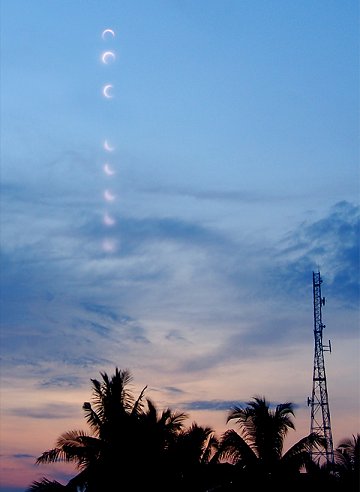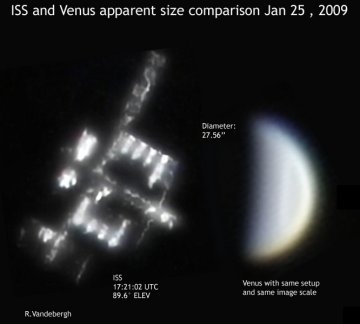| NAMIBIA FIREBALL: Last night, Jan. 27th, around 2105 local time in Namibia, sky watchers witnessed a slow, bright fireball that disintegrated into "thousands of lights, almost like fireworks," says Crone Bergh of Windhoek. Fragments of "various sizes [appeared to be on fire] and left white smoke trails in the air," adds J.C. Vorster, also of Windhoek. This was probably the expected reentry of a Russian Molniya-M rocket, which launched a military satellite in Dec. 2008. The ground track of the decaying rocket passed over Namibia in a direction that fits the description of the witnesses. Readers, if you saw or photographed this event, please submit a report. CLOUDY ECLIPSE: Sometimes clouds are a good thing; the solar eclipse of Jan. 26, 2009, was one of those times. Jia Hao sends this report from Carita, Indonesia: "The thickness of clouds during the annular phase of the eclipse was just right to make the ring a naked eye view. We literally saw a golden ring hanging there without any filter." He photographed the spectacle using a Nikon D50: 
"At the same time," he adds, "the surroundings were getting dark and hundreds of swallows were flying in a panic above us. The view was just as amazing as a total solar eclipse!" In nearby Bandar Lampung, onlooker Dhani Herdiwijaya agreed: "It was really a beautiful moment to catch the 'ring of god' among the capricious clouds." Browse the gallery for more: UPDATED: Jan. 26 Solar Eclipse Gallery
[Submit your photos] [Animated eclipse maps] VENUS AND THE ISS: When the International Space Station (ISS) glides across the night sky, its brilliant silvery light reminds many observers of Venus. Here's why: 
Venus and the ISS are almost exactly the same apparent size and brightness. "I photographed the pair on the evening of Jan. 25th," says Ralf Vandebergh of the Netherlands."The ISS was making a high pass over my backyard observatory. I manually tracked it using a 10-inch Newtonian reflector." He then swung the telescope around and photographed Venus using the same setup. The ISS is making a series of bright evening passes over Europe this week and North America next week. Venus will be in the sky at the same time, so you can compare the two with your own eyes. Check the Simple Satellite Tracker for flyby times.
Comet Lulin Photo Gallery
[Comet Hunter telescope] [sky map] [ephemeris]
Explore the Sunspot Cycle | 
